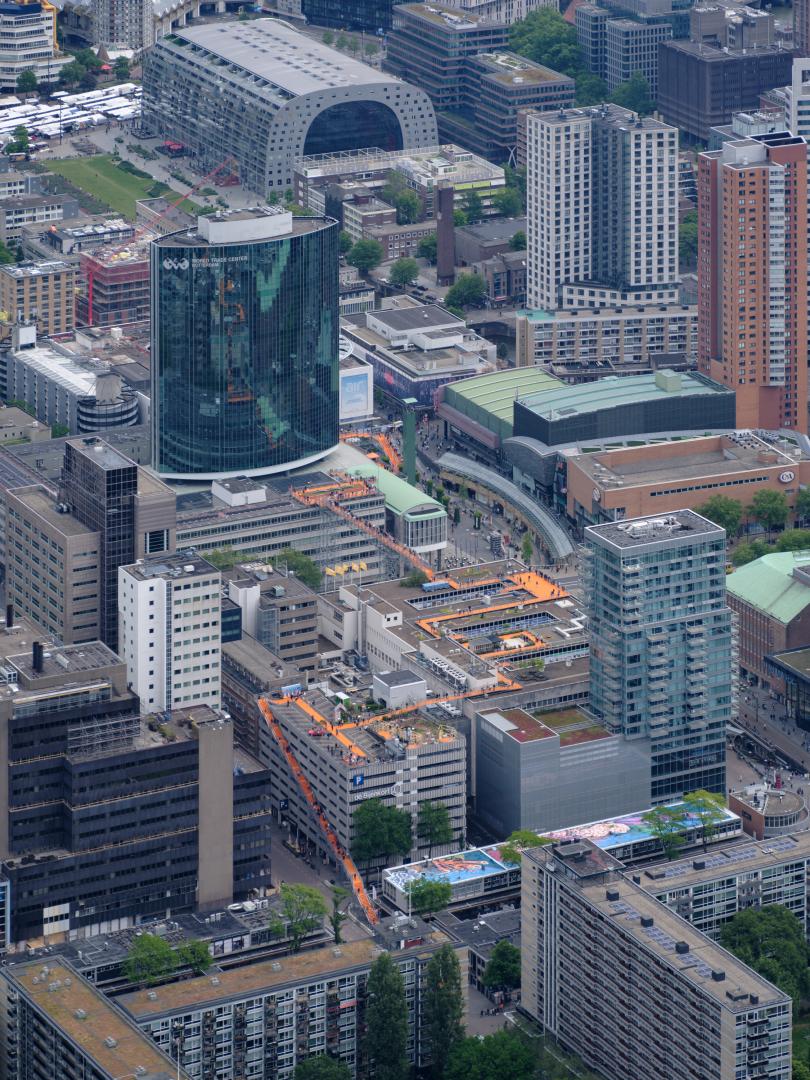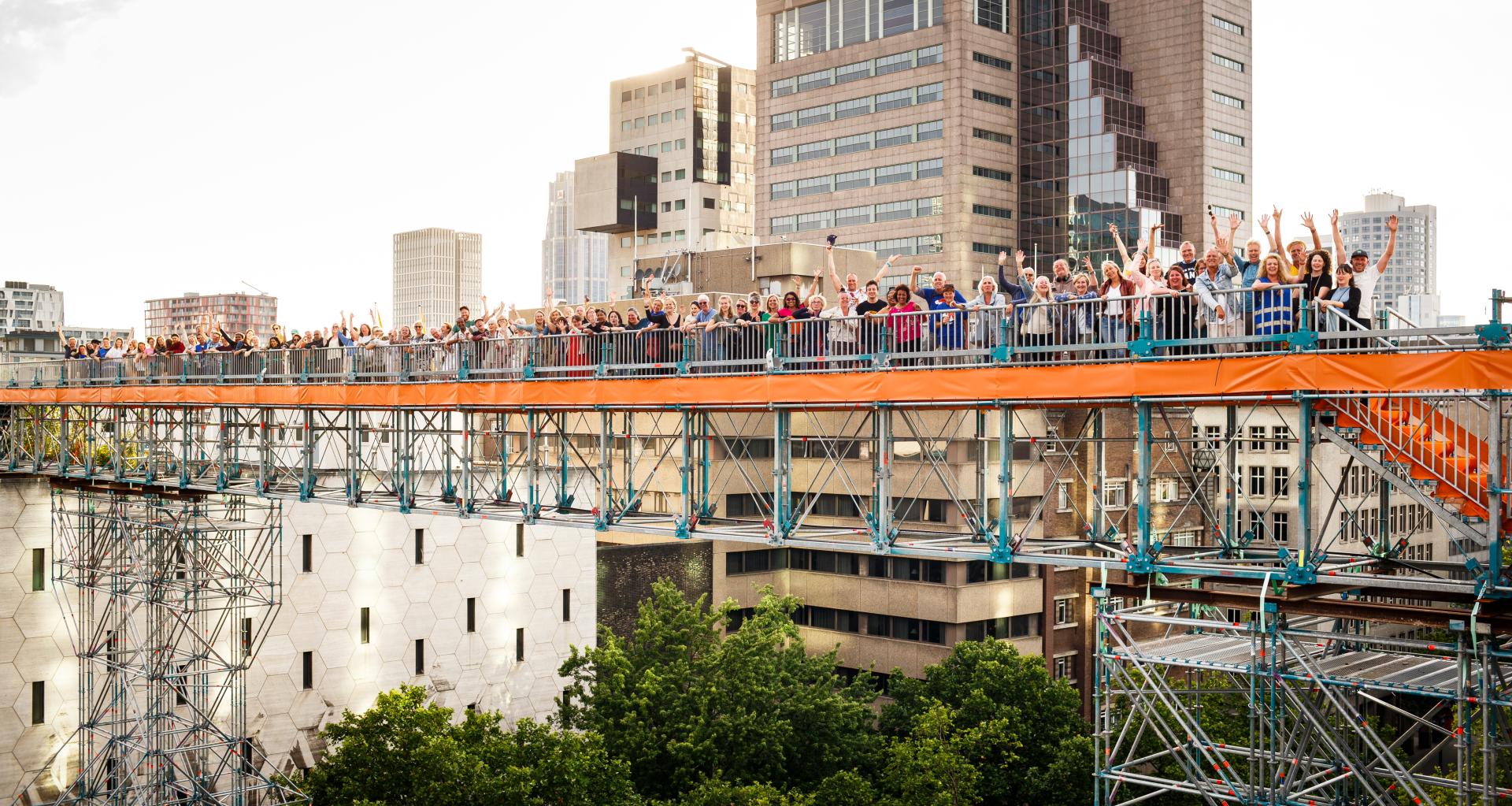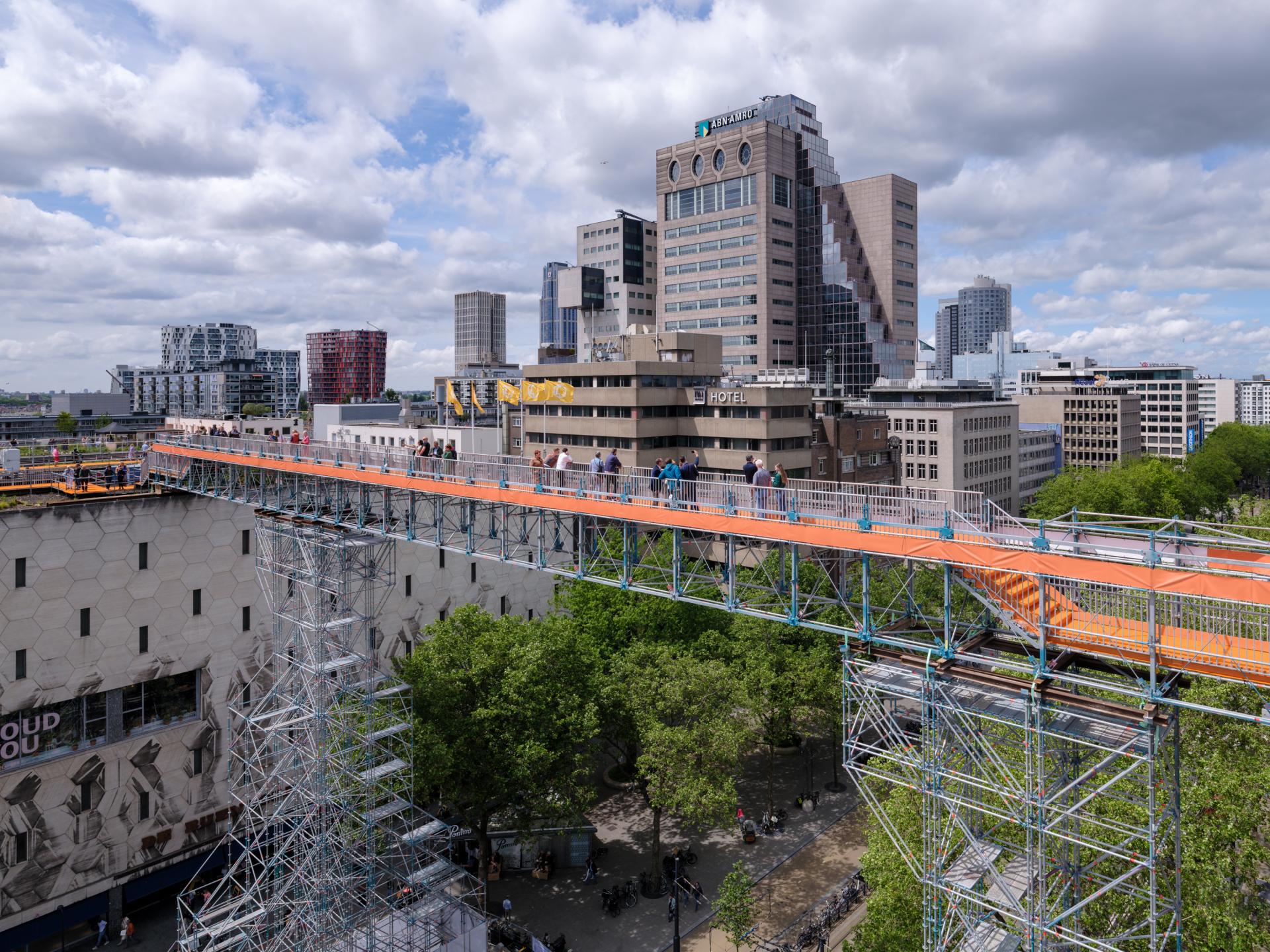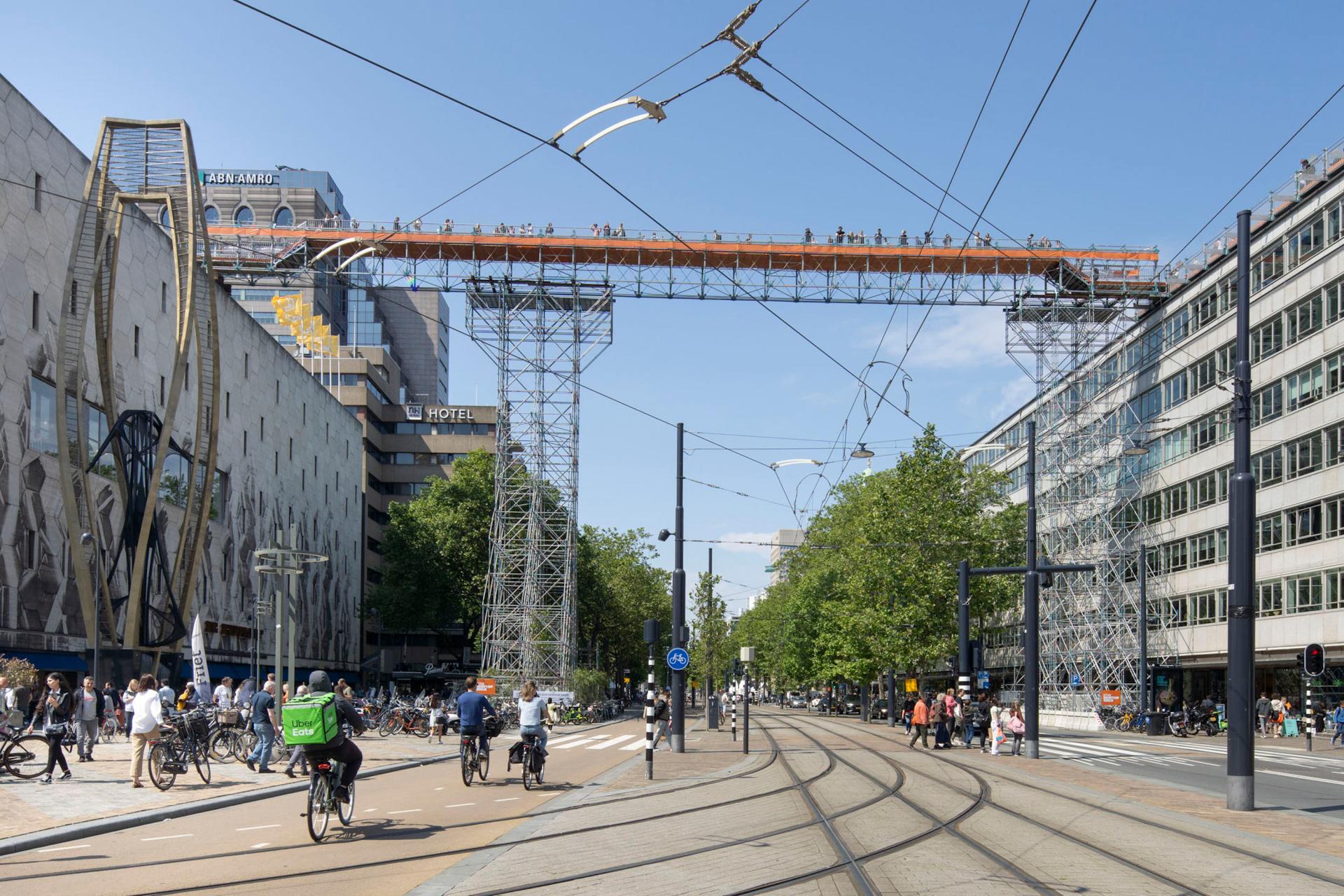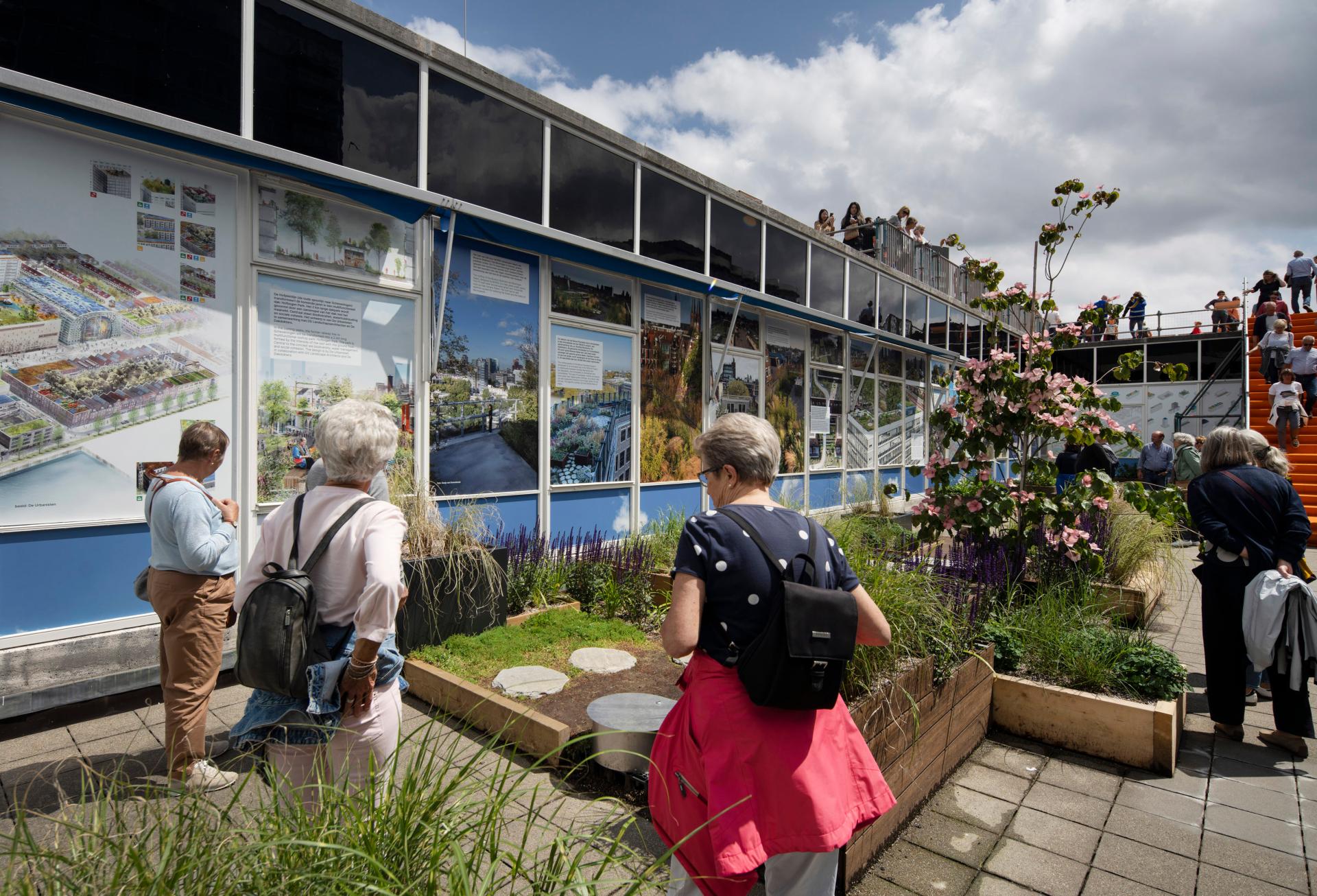Rotterdam Rooftop Walk 2022
Basic information
Project Title
Rotterdam Rooftop Walk 2022
Full project title
Rotterdam Rooftop Walk - experience the potential of urban rooftops
Category
Regaining a sense of belonging
Project Description
In one month, over 200.000 visitors experienced the Rotterdam Rooftop Walk. Stairways attached to the exterior of buildings provided access to monumental rooftops, connected by a bridge suspended 30 metres above the city’s main thoroughfare. This installation and exhibition presented an urban landscape where public space continues on the rooftop level, uncovering the untapped potential of rooftop space in Rotterdam as well as other densely populated cities worldwide.
Geographical Scope
National
Project Region
Rotterdam
Zuid-Holland, Netherlands
Zuid-Holland, Netherlands
Urban or rural issues
Mainly urban
Physical or other transformations
It refers to other types of transformations (soft investment)
EU Programme or fund
Yes
Which funds
Creative Europe
Description of the project
Summary
Rotterdam Rooftop Walk provided a month of spectacular sights in Rotterdam: from 26 May to 26 June 2022, an audience of over 200.000 people experienced how rooftops can contribute to a better future for densifying cities. The project was initiated, designed and executed by the organisation Rotterdamse Dakendagen, an NGO that (among other things) organises and curates events on rooftops as a way of promoting utilising rooftop space towards a more sustainable future in urban environments.
The Rotterdam Rooftop Walk was an installation consisting of stairs and bridges, connecting rooftops to the ground level via the exterior of monumental buildings in the city’s commercial district. The intent was for a large audience to experience the potential of flat rooftops as an extension of public space, providing opportunities for green spaces, recreation, cultural and artistic expression, sports, energy generation and water retention. It presented a tangible and vibrant vision of the future for densifying urban areas: the layered city. The eye-catching route featured a 60 metre bridge suspended 30 metres above Rotterdam’s main thoroughfare and was constructed with scaffolding and other reusable materials.
The Rotterdam Rooftop Walk told the story of a better future for cities worldwide, focussing on the wellbeing of its inhabitants and visitors. Programmed along the route, audiences experienced an exhibition of surprising, creative and innovative forms of rooftop use, curated in co-creation with designers, architects, landscape architects and artists alike. https://rooftopwalk.nl/programme-overview/?lang=en
204,000 tickets were sold for the temporary walkway, which was accessible for 32 days. The audience was diverse, local, regional, national and international. The relevance was clear to all groups, for this is not just the story of Rotterdam, but the story of the untapped potential of rooftops in cities worldwide.
The Rotterdam Rooftop Walk was an installation consisting of stairs and bridges, connecting rooftops to the ground level via the exterior of monumental buildings in the city’s commercial district. The intent was for a large audience to experience the potential of flat rooftops as an extension of public space, providing opportunities for green spaces, recreation, cultural and artistic expression, sports, energy generation and water retention. It presented a tangible and vibrant vision of the future for densifying urban areas: the layered city. The eye-catching route featured a 60 metre bridge suspended 30 metres above Rotterdam’s main thoroughfare and was constructed with scaffolding and other reusable materials.
The Rotterdam Rooftop Walk told the story of a better future for cities worldwide, focussing on the wellbeing of its inhabitants and visitors. Programmed along the route, audiences experienced an exhibition of surprising, creative and innovative forms of rooftop use, curated in co-creation with designers, architects, landscape architects and artists alike. https://rooftopwalk.nl/programme-overview/?lang=en
204,000 tickets were sold for the temporary walkway, which was accessible for 32 days. The audience was diverse, local, regional, national and international. The relevance was clear to all groups, for this is not just the story of Rotterdam, but the story of the untapped potential of rooftops in cities worldwide.
Key objectives for sustainability
The key objectives in our project were awareness and engagement: letting a large and wide audience experience the possibilities of urban rooftop utilisation for a sustainable urban environment.
Rooftops offer a wealth of space that is most often overlooked because of a lack of vision, technical knowhow, policy initiatives and cultural awareness. Only through cooperation and co-creation between private, non-profit and commercial sectors can this resource be utilised on a large scale. However, this requires a sense of urgency and imagination. We must be able to see ourselves using rooftops, in order to believe it. By providing access to a usually inaccessible space and by doing so on a massive scale, we wanted to completely forgo the exclusivity that is often relegated to rooftop space when it is used. We wanted to focus on accessibility in the broadest sense of the word, lowering the literal and figurative threshold and making rooftop space public and inclusive. And while occupying this space we sought to engage the general public, in a positive and joyful way, with hard-to-grasp themes of urban sustainability and transition.
We were able to meet these objectives only through cooperation with local, national and international partners. We have welcomed over 200.000 visitors who rated the experience with an 8.7 out of 10. The press coverage was overwhelming, reaching 130 million recorded views in the Netherlands and 457 million outside of the Netherlands.
Rooftops offer a wealth of space that is most often overlooked because of a lack of vision, technical knowhow, policy initiatives and cultural awareness. Only through cooperation and co-creation between private, non-profit and commercial sectors can this resource be utilised on a large scale. However, this requires a sense of urgency and imagination. We must be able to see ourselves using rooftops, in order to believe it. By providing access to a usually inaccessible space and by doing so on a massive scale, we wanted to completely forgo the exclusivity that is often relegated to rooftop space when it is used. We wanted to focus on accessibility in the broadest sense of the word, lowering the literal and figurative threshold and making rooftop space public and inclusive. And while occupying this space we sought to engage the general public, in a positive and joyful way, with hard-to-grasp themes of urban sustainability and transition.
We were able to meet these objectives only through cooperation with local, national and international partners. We have welcomed over 200.000 visitors who rated the experience with an 8.7 out of 10. The press coverage was overwhelming, reaching 130 million recorded views in the Netherlands and 457 million outside of the Netherlands.
Key objectives for aesthetics and quality
This project literally gave a new perspective to the future city. Firstly via an unavoidable eye-catcher in the city centre: a bridge connecting two buildings, high above the city’s main thoroughfare, with exterior stairways connecting the street level to the rooftops. The installation itself was a temporary architectural intervention, co-designed by Rotterdamse Dakendagen with internationally renowned firms MVRDV and LOLA Landscape Architects among others. By connecting monumental, post-war buildings de Bijenkorf and WTC Rotterdam it transformed a very well-known cityscape. The use of colour (orange) was deliberate: colour-coding to signify different forms of rooftop use is an internationally recognised practice which originated in Rotterdam. Yellow for energy generation, green for green, red for social use etc. Orange symbolises mobility: using rooftop space to create new ways to get to where you want to go. The bright colour in a concrete jungle had the added benefit of highlighting the installation, especially striking from a bird’s eye view.
It was designed to be a dynamic experience, a route with a beginning and an end: like taking a walk from A to B. The exhibition, with tangible and innovative forms of rooftop use, provided context to the visitor, while never breaking the flow of the walk. Even though the experience took place at great height, the movement was never frantic, stressful or exhilarating. The walk intentionally felt like a meandering stroll, allowing the visitor to muse, take in the sights and think about their environment. By carefully managing the flow (with time slots and constantly adjusting capacity based on the current situation), visitors were constantly entering and exiting the installation, taking a walk without too much waiting or a sense of hurry. This solidified the potential of utilising rooftop space in a casual sense, in everyday life.
It was designed to be a dynamic experience, a route with a beginning and an end: like taking a walk from A to B. The exhibition, with tangible and innovative forms of rooftop use, provided context to the visitor, while never breaking the flow of the walk. Even though the experience took place at great height, the movement was never frantic, stressful or exhilarating. The walk intentionally felt like a meandering stroll, allowing the visitor to muse, take in the sights and think about their environment. By carefully managing the flow (with time slots and constantly adjusting capacity based on the current situation), visitors were constantly entering and exiting the installation, taking a walk without too much waiting or a sense of hurry. This solidified the potential of utilising rooftop space in a casual sense, in everyday life.
Key objectives for inclusion
Our conviction is that if you convince a critical number of city dwellers, inhabitants and visitors alike, of the need for sustainable urban transformation, then the architects, project developers and policymakers will follow the popular demand, democratising urban planning and turning the conventional top-down innovation and transformation on its head. Therefore we attempted to remove as many barriers as possible. We charged a very low entrance fee of 3,50 euros, even when demand became far greater than supply. We also adjusted the installation on specific days for visitors who had difficulty walking or used a wheelchair, by adding ramps and other physician alterations. Most of all we wanted to provide the audience with a sense of place, agency and engagement in changing urban environments, showing innovations and best-practice examples of sustainable transformation. But we wanted to design this process to be joyful and dynamic, engaging city dwellers at the forefront of transition instead of bringing them up to speed after the fact.
Results in relation to category
We have had over 200.000 visitors, represented in our audience survey of 1667 respondents. They appreciated their visit to the Rooftop Walk with an 8.8 out of a possible 10. Media coverage was 130 M in the Netherlands and 457 M outside of the Netherlands.
How Citizens benefit
A team of over 350 people, of which 250 volunteers, were involved in creating and managing the intervention. The 200.000 visitors were represented in audience research by almost 1700 respondents. 87% of them claimed that interventions like the Rooftop Walk were important or very important to their feeling connected to the city. In both groups, we appealed to a sense of community and taking pride in your living environment. Their commitment to help build and to visit the project greatly enhanced its significance, amplifying the conversation about the potential of rooftop use.
Physical or other transformations
It refers to other types of transformations (soft investment)
Innovative character
The innovative character of the project was the playful engagement of a wide audience with urban development, sustainability and (climate) transition, usually discussed by experts among themselves. A positive public conversation through the medium of an urban intervention and an event with local, regional, national and international significance. Similar initiatives have been smaller in scale, simpler in execution and less dynamic.
Disciplines/knowledge reflected
Architects, urban designers, landscape architects, urban ecologists and municipal workers (monuments and urban planners) worked together in adapting the initial designs to the actual execution. Experts in energy transition, solar power, water retention, arts and culture, visual arts, heat island effect, industrial design, circular economy, construction, project development worked together in providing input for the exhibition on the rooftops. The cross-sectoral co-creation brought several complex topics together into one audience experience.
Methodology used
Our approach as an NGO (stichting Rotterdamse Dakendagen) was to bring together our expertise on rooftops and their use as temporary event spaces, with the design expertise of the creative industry and the drive of policy makers and commercial actors to embrace sustainability, social design and new forms of audience participation in urban transitions. We provided these different agents with the opportunity to work together, involving the audience through the medium of a cultural event, greatly lowering their threshold of participation, bringing playfulness, joy and momentum to this placemaking effort.
How stakeholders are engaged
The municipality and other stakeholders like local businesses, asset managers of buildings and project developers were highly involved in the implementation and success of the project: without their commitment and cooperation the project would not have been successful. Both regional (on the provincial level) and national (ministerial) representatives of government visited the project with delegations, speaking to local representatives and participants and exchanging ideas. European partner cities from the European Creative Rooftop Network (supported by Creative Europe in 2021-2024) provided programming input and visited the installation in an international rooftop knowledge day, meeting with cultural agents and other professionals and discussing rooftop use from their local perspective.
Global challenges
Climate change (biodiversity, water retention, heat island effect), Energy transition (solar and wind energy) and social cohesion (providing qualitative public space and encouraging city dwellers to meet each other).
Learning transferred to other parties
The teachings, learnings and thoughts of this project have already transferred to other places and people. Other cities, both on the national and international level have shown interest in using similar ways of showing the potential of rooftop usage and have asked for and received advice on how to tailor such an event to their specific, local situation.
Keywords
Utilisation of rooftop space as untapped urban potential
Agency and awareness of civilians in sustainability
Arts and culture interconnected with other sectors
Cross-sectoral cooperation and co-creation
Urban social design

